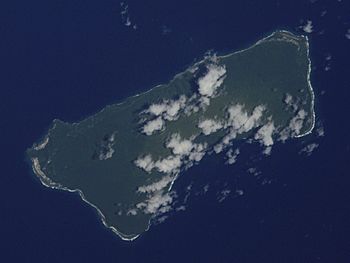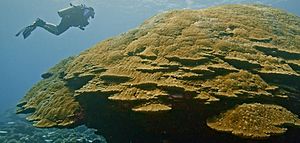Taʻū facts for kids

Ta'u as seen from space
|
|
| Geography | |
|---|---|
| Location | Southern Pacific Ocean |
| Coordinates | 14°14′S 169°28′W / 14.233°S 169.467°W |
| Area | 44.31 km2 (17.11 sq mi) |
| Highest elevation | 931 m (3,054 ft) |
| Highest point | Lata Mountain |
| Administration | |
|
United States
|
|
| Territory of the United States | American Samoa |
| Demographics | |
| Population | 790 (in 2010) |
Taʻū is the biggest island in the Manuʻa Group. It is the easternmost volcanic island in the Samoan Islands. Taʻū is part of American Samoa. A long time ago, in the early 1800s, people sometimes called it Opoun.
Taʻū is famous for a few reasons. An American scientist named Margaret Mead studied here in the 1920s. She wrote a book called Coming of Age in Samoa about her research. Taʻū also has the highest mountain in American Samoa, called Mount Lata. A large part of the island, about 8.3 square miles (21.5 km²), is part of the National Park of American Samoa. There are also 1.5 square miles (3.9 km²) of ocean waters. These waters are next to some of the world's tallest sea cliffs.
On the west coast of Taʻū, you'll find two villages, Lumā and Siufaga. They are often called "Taʻū village" together. This village is the capital of the Manu'a Islands. Another village, Fitiuta, is on the northeast side of the island.
Exploring Taʻū's Geography
Taʻū Island is what's left of an old hotspot volcano. It has a special collapsed area called Liu Bench on its south side. The highest point on the island is Lata Mountain, which is 931 meters (3,054 feet) tall. This makes it the highest spot in all of American Samoa. The last time a volcano erupted in the Manuʻa Islands was in 1866. This eruption happened underwater, near Ofu-Olosega.
The main airport in the Manuʻa Islands is on Taʻū. It is located at Fitiʻuta, on the northeast side. There is also a smaller private airport. A boat harbor can be found at Faleāsao, on the northwest side of the island. A road runs along the north coast. It connects all the villages from Taʻū in the west to Fitiʻuta.
A big part of southeastern Taʻū is part of the National Park of American Samoa. This includes the rainforest on Lata Mountain and inside the old volcano. It also covers the southern coastline and its coral reefs. The park protects an ancient, sacred place called Saua. Many people believe this is where the Polynesian people first came from.
Taʻū Island is divided into three areas for local government. These are Faleasao County, Fitiuta County, and Ta'u County. Taʻū Island, along with Ofu and Olosega islands, makes up the Manu'a District of American Samoa. The island covers about 44.31 square kilometers (17.11 sq mi). In 2010, about 790 people lived there.
In 2000, scientists found an underwater volcano about 30 miles (48 km) from Taʻū Island. This volcano, called Rockne, has formed a huge undersea mountain. It is 14,000 feet (4,300 m) tall. Its top is still 18,000 feet (5,500 m) below the ocean surface.
Margaret Mead's Research
Taʻū is where a young scientist named Margaret Mead did her important research. She was 23 years old when she came to Samoa in the 1920s. She wrote about her findings in a book called Coming of Age in Samoa in 1928.
In her book, she studied teenage girls. She compared their lives in Samoa to the lives of teens in Western countries. She believed that growing up in Samoa was a calm process. It did not have the stress or confusion often seen in the United States.
Powering the Island with Sun
Before 2016, Taʻū Island used expensive and polluting diesel generators for electricity. Because the island is small and far away, this was a big challenge.
But now, things are different! A new solar power system was built. It includes solar panels, large batteries to store energy, and a special power network. Now, almost all of the island's electricity comes from the sun.
The company SolarCity built this solar system. It uses sixty Tesla Powerpacks, which are like giant batteries. This system gives the island a more reliable source of energy. It can power the whole island for three days without sunlight. It can also fully recharge in just seven hours.
See also
In Spanish: Ta'u para niños


